-

新人教版高中英语必修3Unit 1 Festivals and Celebrations-Reading for Writing教学设计一
The topic of this part is “Write about your festival experience”.During the Listening and Speaking and Talking, students are just asked to say out their festival experiences such as the Spring Festival, Mid-autumn Day, but this part students will be asked to write down their own festival experiences. During the reading part, it introduces the Naadam Festival in Inner Mongolia Autonomous Region, which can give students a good example to imitate. Students not only learn the festival, but touch and feel the Inner Mongolian’s character, the spirit and cultural atmosphere, which can help students form the cultural awareness and learn to enjoy and value the diversity of Chinese culture.Concretely, the dairy tells the experience that the author spent the Naadam Festival in Inner Mongolia Autonomous Region with his/her friend. The structure is clear. In the opening paragraph, it introduces the topic of the Naadam Festival and the whole feeling. Then it introduces the items of the festival like the ceremony, wrestling and horse racing. Finally, it summarizes this experience. Because this part is a travel journal, we must guide students pay more attention to these details: 1. use the first person. 2. use the past tense to tell the past thing and use the present or future tense to describe the scenery. 3. use the timeline to tell the development. 4. be careful for the author’s psychology, emotion and feeling, etc.1. Read quickly to get main idea; read carefully to get the detailed information about Naadam Festival.2. Learn the structure of the reading article and language.3. Write an article about a festival experience4. Learn to use the psychology, emotions and feeling in the writing.1. Write an article about a festival experience.2. Use the structure of the reading article and language.
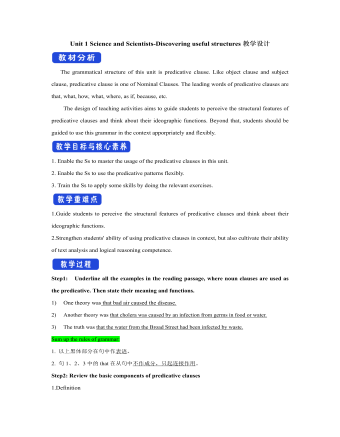
新人教版高中英语选修2Unit 1 Science and Scientists-Discovering useful structures教学设计
The grammatical structure of this unit is predicative clause. Like object clause and subject clause, predicative clause is one of Nominal Clauses. The leading words of predicative clauses are that, what, how, what, where, as if, because, etc.The design of teaching activities aims to guide students to perceive the structural features of predicative clauses and think about their ideographic functions. Beyond that, students should be guided to use this grammar in the context apporpriately and flexibly.1. Enable the Ss to master the usage of the predicative clauses in this unit.2. Enable the Ss to use the predicative patterns flexibly.3. Train the Ss to apply some skills by doing the relevant exercises.1.Guide students to perceive the structural features of predicative clauses and think about their ideographic functions.2.Strengthen students' ability of using predicative clauses in context, but also cultivate their ability of text analysis and logical reasoning competence.Step1: Underline all the examples in the reading passage, where noun clauses are used as the predicative. Then state their meaning and functions.1) One theory was that bad air caused the disease.2) Another theory was that cholera was caused by an infection from germs in food or water.3) The truth was that the water from the Broad Street had been infected by waste.Sum up the rules of grammar:1. 以上黑体部分在句中作表语。2. 句1、2、3中的that在从句中不作成分,只起连接作用。 Step2: Review the basic components of predicative clauses1.Definition
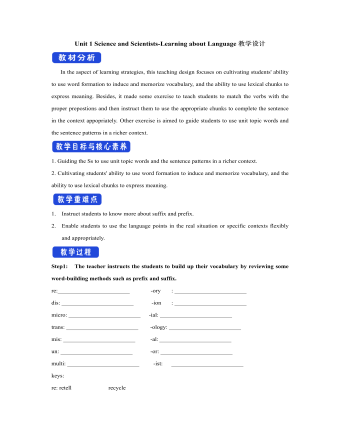
新人教版高中英语选修2Unit 1 Science and Scientists-Learning about Language教学设计
Step 7: complete the discourse according to the grammar rules.Cholera used to be one of the most 1.__________ (fear) diseases in the world. In the early 19th century, _2_________ an outbreak of cholera hit Europe, millions of people died. But neither its cause, 3__________ its cure was understood. A British doctor, John Snow, wanted to solve the problem and he knew that cholera would not be controlled _4_________ its cause was found. In general, there were two contradictory theories 5 __________ explained how cholera spread. The first suggested that bad air caused the disease. The second was that cholera was caused by an _6_________(infect) from germs in food or water. John Snow thought that the second theory was correct but he needed proof. So when another outbreak of cholera hit London in 1854, he began to investigate. Later, with all the evidence he _7_________ (gather), John Snow was able to announce that the pump water carried cholera germs. Therefore, he had the handle of the pump _8_________ (remove) so that it couldn't be used. Through his intervention,the disease was stopped in its tracks. What is more, John Snow found that some companies sold water from the River Thames that __9__________________ (pollute) by raw waste. The people who drank this water were much more likely _10_________ (get) cholera than those who drank pure or boiled water. Through John Snow's efforts, the _11_________ (threaten) of cholera around the world saw a substantial increase. Keys: 1.feared 2.when 3. nor 4.unless 5.that/which 6.infection 7.had gathered 8.removed 9.was polluted 10.to get 11. threat
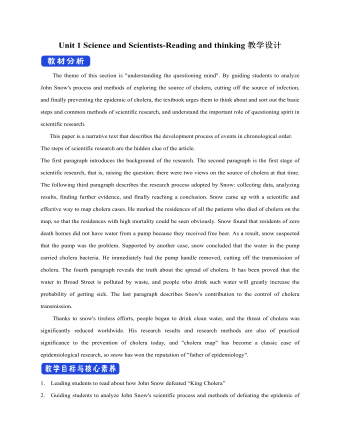
新人教版高中英语选修2Unit 1 Science and Scientists-Reading and thinking教学设计
Step 5: After learning the text, discuss with your peers about the following questions:1.John Snow believed Idea 2 was right. How did he finally prove it?2. Do you think John Snow would have solved this problem without the map?3. Cholera is a 19th century disease. What disease do you think is similar to cholera today?SARS and Covid-19 because they are both deadly and fatally infectious, have an unknown cause and need serious public health care to solve them urgently.keys:1. John Snow finally proved his idea because he found an outbreak that was clearly related to cholera, collected information and was able to tie cases outside the area to the polluted water.2. No. The map helped John Snow organize his ideas. He was able to identify those households that had had many deaths and check their water-drinking habits. He identified those houses that had had no deaths and surveyed their drinking habits. The evidence clearly pointed to the polluted water being the cause.3. SARS and Covid-19 because they are both deadly and fatally infectious, have an unknown cause and need serious public health care to solve them urgently.Step 6: Consolidate what you have learned by filling in the blanks:John Snow was a well-known _1___ in London in the _2__ century. He wanted to find the _3_____ of cholera in order to help people ___4_____ it. In 1854 when a cholera __5__ London, he began to gather information. He ___6__ on a map ___7___ all the dead people had lived and he found that many people who had ___8____ (drink) the dirty water from the __9____ died. So he decided that the polluted water ___10____ cholera. He suggested that the ___11__ of all water supplies should be _12______ and new methods of dealing with ____13___ water be found. Finally, “King Cholera” was __14_____.Keys: 1. doctor 2. 19th 3.cause 4.infected with 5.hit 6.marked 7.where 8.drunk 9.pump 10.carried 11.source 12.examined 13.polluted 14.defeatedHomework: Retell the text after class and preview its language points
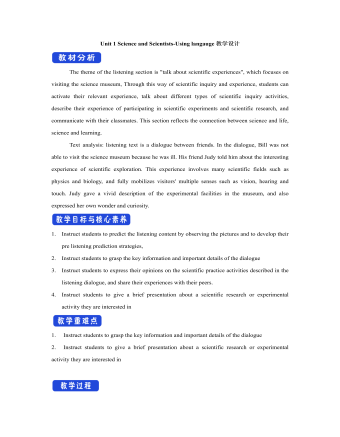
新人教版高中英语选修2Unit 1 Science and Scientists-Using langauge教学设计
This happens because the dish soap molecules have a strong negative charge, and the milk molecules have a strong positive charge. Like magnets, these molecules are attracted to each other, and so they appear to move around on the plate, taking the food coloring with them, making it look like the colors are quickly moving to escape from the soap.Listening text:? Judy: Oh, I'm so sorry that you were ill and couldn't come with us on our field trip. How are you feeling now? Better?? Bill: Much better, thanks. But how was it?? Judy: Wonderful! I especially liked an area of the museum called Light Games.it was really cool. They had a hall of mirrors where I could see myself reflected thousands of times!? Bill: A hall of mirrors can be a lot of fun. What else did they have?? Judy: Well, they had an experiment where we looked at a blue screen for a while, and then suddenly we could see tiny bright lights moving around on it. You'll never guess what those bright lights were!? Bill: Come on, tell me!? Judy: They were our own blood cells. For some reason, our eyes play tricks on us when we look at a blue screen, and we can see our own blood cells moving around like little lights! But there was another thing I liked better. I stood in front of a white light, and it cast different shadows of me in every color of the rainbow!? Bill: Oh, I wish I had been there. Tell me more!? Judy: Well, they had another area for sound. They had a giant piano keyboard that you could use your feet to play. But then, instead of playing the sounds of a piano, it played the voices of classical singers! Then they had a giant dish, and when you spoke into it, it reflected the sound back and made it louder. You could use it to speak in a whisper to someone 17 meters away.? Bill: It all sounds so cool. I wish I could have gone with you? Judy: I know, but we can go together this weekend. I'd love to go there again!? Bill: That sounds like a great idea!
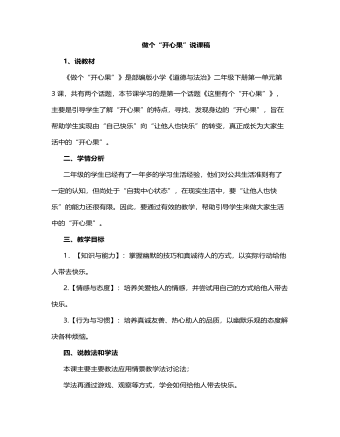
人教部编版道德与法制二年级下册做个“开心果”说课稿
1、课件出示教材第12页图片。学生思考问题,当你们遇到这样的情况时,你们会怎么做?学生活动;学生讨论交流。教师小结:孩子们,你们的做法非常正确。我希望你们能够按照自己说的那样去做,成为当之无愧的开心果。2、课件出示教材第13页情境图(扫地的妈妈咳嗽;唉声叹气的爸爸;发怒的爷爷;哭泣的小妹妹。)请同学们猜一猜这些人遇到了什么情况?你们是怎么判断出来的?你们会怎么做呢?学生活动:学生思考后畅所欲言。学生1:通过观察动作,我发现妈妈边扫地边咳嗽,然后我会帮助妈妈扫地,让妈妈休息。学生2:通过观察表情,我发现爸爸遇到不开心的事,然后我会给爸爸讲笑话,逗他开心。学生3:通过观察表情,我发现爷爷很生气,然后我会帮爷爷捶捶背,让爷爷放轻松。学生4:通过观察表情,我发现小妹妹在哭位,然后我会开导她,哄她开心。教师总结:同学们说得很好。我希望你们以后遇到类似的情况时,能够及时给他人带去快乐,做个“开心果”。
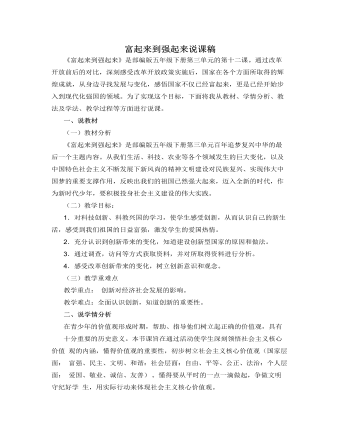
人教部编版道德与法制五年级下册富起来到强起来说课稿
4. 今天我们继续学习《富起来到强起来》 。 活动一:了解社会主义核心价值观1. 看过了视频,接下来由各个小组与我们分享他们在课下准备的核心价值 观小品,每组表演时,剩下的小组猜测表演的是哪一个核心价值观并在活动评 价单上进行评分。2. 教师总结:“精神文明建设使人们的生活更美好”教师引导学生:精神文明建设搞好了,人心凝聚,精神振奋,各项事业才 会全面兴盛。活动二:走进新时代,怀揣中国梦。1. 播放“中国梦”优秀少儿演讲视频。2. 阅读课本,交流感想。 活动三:争做时代好少年1. 回顾各小组的表演,把其中所有的不良习惯和闪光举动逐个挑出来再次 强调。2. 小组交流班级内部常见的坏习惯。教师总结。 总结延伸:通过本节课的学习了解到青少儿应积极投身于社会主义精神文明建设的伟 大实践中去,做新时代的好少,做新时期中国先进文化的传播者。
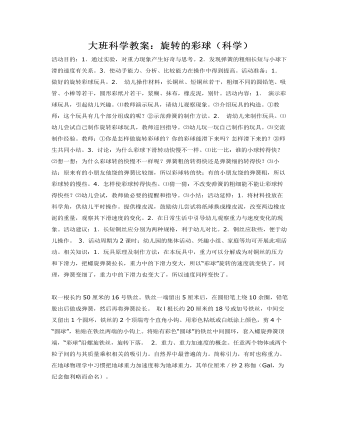
大班科学教案:旋转的彩球(科学)
2.幼儿操作材料:长铜丝、短铜丝若干,粗细不同的圆铅笔、吸管、小棒等若干,圆形彩纸片若干,浆糊、抹布,橡皮泥,别针。活动内容:1.演示彩球玩具,引起幼儿兴趣。⑴教师演示玩具,请幼儿观察现象。⑵介绍玩具的构造。①教师:这个玩具有几个部分组成的呢?②示范弹簧的制作方法。2.请幼儿来制作玩具。⑴幼儿尝试自己制作旋转彩球玩具,教师巡回指导。⑵幼儿玩一玩自己制作的玩具。⑶交流制作经验。教师:①你是怎样做旋转彩球的?你的彩球能滑下来吗?怎样滑下来的?②师生共同小结。3.讨论:为什么彩球下滑转动快慢不一样。⑴比一比:谁的小球转得快?⑵想一想:为什么彩球转的快慢不一样呢?弹簧粗的转得快还是弹簧细的转得快?⑶小结:原来有的小朋友他绕的弹簧比较细,所以彩球转的快;有的小朋友绕的弹簧粗,所以彩球转的慢些。4.怎样使彩球转得快些。⑴猜一猜:不改变弹簧的粗细能不能让彩球转得快些?⑵幼儿尝试,教师做必要的提醒和指导。⑶小结:活动延伸:1.将材料投放在科学角,供幼儿平时操作。提供橡皮泥,鼓励幼儿尝试将纸球换成橡皮泥,改变两边橡皮泥的重量,观察其下滑速度的变化。2.在日常生活中引导幼儿观察重力与速度变化的现象。活动建议:1.长短铜丝应分别为两种规格,利于幼儿对比。
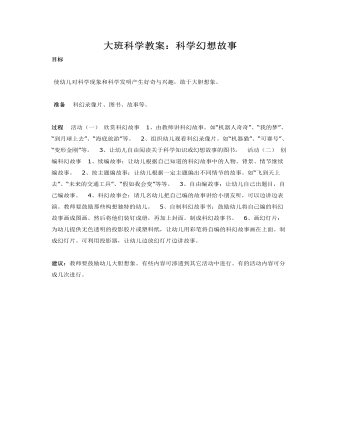
大班科学教案:科学幻想故事
过程 活动(一)欣赏科幻故事 1、由教师讲科幻故事。如“机器人奇奇”、“我的梦”、“到月球上去”、“海底旅游”等。 2、组织幼儿观看科幻录像片。如“机器猫”、“可赛号”、“变形金刚”等。 3、让幼儿自由阅读关于科学知识或幻想故事的图书。 活动(二)创编科幻故事 1、续编故事:让幼儿根据自己知道的科幻故事中的人物、背景、情节继续编故事。
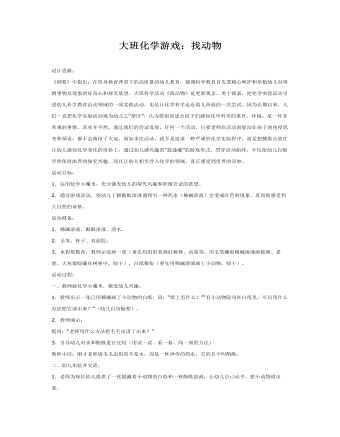
大班科学教案:化学游戏:找动物
活动目标: 1.运用化学小魔术,充分激发幼儿的探究兴趣和积极尝试的欲望。 2.通过游戏活动,使幼儿了解酚酞溶液遇到另一种药水(稀碱溶液)会变成红色的现象,真切地感受到大自然的奇妙。 活动准备: 1.稀碱溶液、酚酞溶液、清水。 2.毛笔、杯子、双面胶; 3.水彩纸数张,教师示范画一张(事先均用彩笔画好树林、房屋等,用毛笔蘸取稀碱溶液画狐狸、老虎、大灰狼隐藏在树林中,晾干),白纸数张(事先用稀碱溶液画上小动物,晾干)。 活动过程: 一、教师做化学小魔术,激发幼儿兴趣。 1.教师出示一张已用稀碱画了小动物的白纸,问:“纸上有什么?”“有小动物隐身在白纸里,可以用什么办法把它请出来?”(幼儿自由畅想)。 2.教师演示: 提问:“老师用什么方法把毛毛虫请了出来?” 3.引导幼儿对水和酚酞进行比较(用试一试、看一看、闻一闻的方法) 教师小结:刚才老师请毛毛虫用的不是水,而是一杯神奇的药水,它的名字叫酚酞。
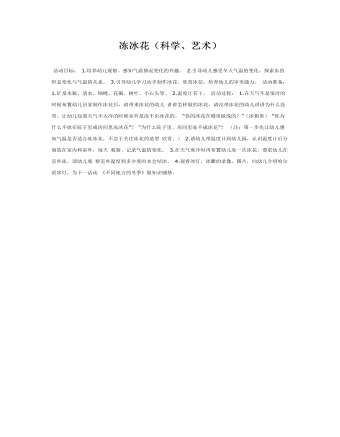
大班科学教案:冻冰花(科学、艺术)
2.引导幼儿感受冬天气温的变化,探索水的形态变化与气温的关系。 3.引导幼儿学习动手制作冰花、欣赏冰花,培养幼儿的审美能力。活动准备: 1.矿泉水瓶、清水、细绳、花瓣、树叶、小石头等。 2.温度计若干。活动过程: 1.在天气不是很冷的时候布置幼儿回家制作冰花后,请带来冰花的幼儿讲讲怎样做的冰花,请没带冰花的幼儿讲讲为什么没带。让幼儿知道天气不太冷的时候室外是冻不出冰花的。 “你的冰花在哪里做成的?”(冰箱里) “你为什么不放在院子里或房间里冻冰花”? “为什么院子里、房间里冻不成冰花”?
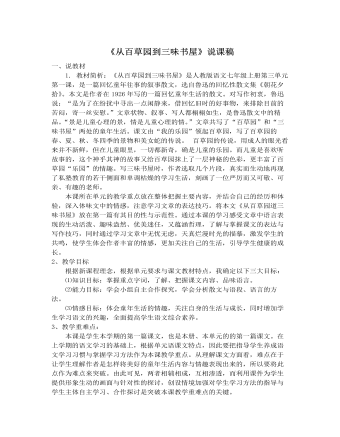
部编版语文七年级上册《从百草园到三味书屋》说课稿
2、教学目标根据新课程理念,根据单元要求与课文教材特点,我确定以下三大目标:⑴知识目标:掌握重点字词,了解、把握课文内容、品味语言。⑵能力目标:学会小组自主合作探究,学会分析散文与语段、语言的方法。⑶情感目标:体会童年生活的情趣,关注自身的生活与成长,同时增加学生学习语文的兴趣,全面提高学生语文综合素养。3、教学重难点:本课是学生本学期的第一篇课文,也是本册、本单元的的第一篇课文。在上学期的语文学习的基础上,根据单元语课文特点,因此要把指导学生养成语文学习习惯与掌握学习方法作为本课教学重点。从理解课文方面看,难点在于让学生理解作者是怎样将美好的童年生活内容与情趣表现出来的,所以要将此点作为难点来突破。由此可见,两者相辅相成,互相渗透,而利用课件为学生提供形象生动的画面与针对性的探讨,创设情境加强对学生学习方法的指导与学生主体自主学习、合作探讨是突破本课教学重难点的关键。

抛物线的简单几何性质(2)教学设计人教A版高中数学选择性必修第一册
二、直线与抛物线的位置关系设直线l:y=kx+m,抛物线:y2=2px(p>0),将直线方程与抛物线方程联立整理成关于x的方程k2x2+2(km-p)x+m2=0.(1)若k≠0,当Δ>0时,直线与抛物线相交,有两个交点;当Δ=0时,直线与抛物线相切,有一个切点;当Δ<0时,直线与抛物线相离,没有公共点.(2)若k=0,直线与抛物线有一个交点,此时直线平行于抛物线的对称轴或与对称轴重合.因此直线与抛物线有一个公共点是直线与抛物线相切的必要不充分条件.二、典例解析例5.过抛物线焦点F的直线交抛物线于A、B两点,通过点A和抛物线顶点的直线交抛物线的准线于点D,求证:直线DB平行于抛物线的对称轴.【分析】设抛物线的标准方程为:y2=2px(p>0).设A(x1,y1),B(x2,y2).直线OA的方程为: = = ,可得yD= .设直线AB的方程为:my=x﹣ ,与抛物线的方程联立化为y2﹣2pm﹣p2=0,
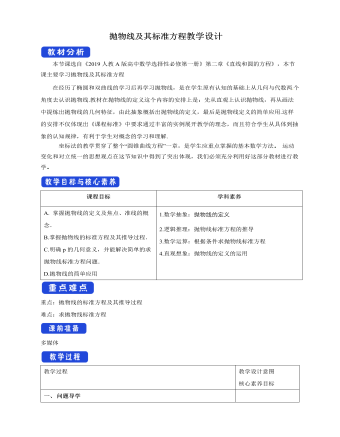
抛物线及其标准方程教学设计人教A版高中数学选择性必修第一册
本节课选自《2019人教A版高中数学选择性必修第一册》第二章《直线和圆的方程》,本节课主要学习抛物线及其标准方程在经历了椭圆和双曲线的学习后再学习抛物线,是在学生原有认知的基础上从几何与代数两 个角度去认识抛物线.教材在抛物线的定义这个内容的安排上是:先从直观上认识抛物线,再从画法中提炼出抛物线的几何特征,由此抽象概括出抛物线的定义,最后是抛物线定义的简单应用.这样的安排不仅体现出《课程标准》中要求通过丰富的实例展开教学的理念,而且符合学生从具体到抽象的认知规律,有利于学生对概念的学习和理解.坐标法的教学贯穿了整个“圆锥曲线方程”一章,是学生应重点掌握的基本数学方法 运动变化和对立统一的思想观点在这节知识中得到了突出体现,我们必须充分利用好这部分教材进行教学

双曲线及其标准方程教学设计人教A版高中数学选择性必修第一册
∵在△EFP中,|EF|=2c,EF上的高为点P的纵坐标,∴S△EFP=4/3c2=12,∴c=3,即P点坐标为(5,4).由两点间的距离公式|PE|=√("(" 5+3")" ^2+4^2 )=4√5,|PF|=√("(" 5"-" 3")" ^2+4^2 )=2√5,∴a=√5.又b2=c2-a2=4,故所求双曲线的方程为x^2/5-y^2/4=1.5.求适合下列条件的双曲线的标准方程.(1)两个焦点的坐标分别是(-5,0),(5,0),双曲线上的点与两焦点的距离之差的绝对值等于8;(2)以椭圆x^2/8+y^2/5=1长轴的端点为焦点,且经过点(3,√10);(3)a=b,经过点(3,-1).解:(1)由双曲线的定义知,2a=8,所以a=4,又知焦点在x轴上,且c=5,所以b2=c2-a2=25-16=9,所以双曲线的标准方程为x^2/16-y^2/9=1.(2)由题意得,双曲线的焦点在x轴上,且c=2√2.设双曲线的标准方程为x^2/a^2 -y^2/b^2 =1(a>0,b>0),则有a2+b2=c2=8,9/a^2 -10/b^2 =1,解得a2=3,b2=5.故所求双曲线的标准方程为x^2/3-y^2/5=1.(3)当焦点在x轴上时,可设双曲线方程为x2-y2=a2,将点(3,-1)代入,得32-(-1)2=a2,所以a2=b2=8.因此,所求的双曲线的标准方程为x^2/8-y^2/8=1.当焦点在y轴上时,可设双曲线方程为y2-x2=a2,将点(3,-1)代入,得(-1)2-32=a2,a2=-8,不可能,所以焦点不可能在y轴上.综上,所求双曲线的标准方程为x^2/8-y^2/8=1.
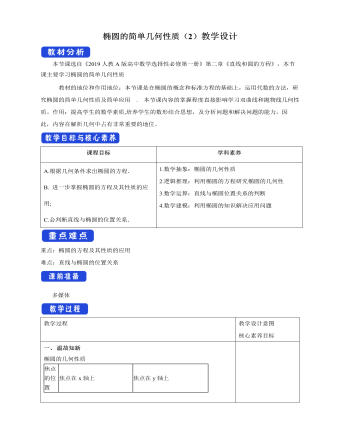
椭圆的简单几何性质(2)教学设计人教A版高中数学选择性必修第一册
二、典例解析例5. 如图,一种电影放映灯的反射镜面是旋转椭圆面(椭圆绕其对称轴旋转一周形成的曲面)的一部分。过对称轴的截口 ABC是椭圆的一部分,灯丝位于椭圆的一个焦点F_1上,片门位另一个焦点F_2上,由椭圆一个焦点F_1 发出的光线,经过旋转椭圆面反射后集中到另一个椭圆焦点F_2,已知 〖BC⊥F_1 F〗_2,|F_1 B|=2.8cm, |F_1 F_2 |=4.5cm,试建立适当的平面直角坐标系,求截口ABC所在的椭圆方程(精确到0.1cm)典例解析解:建立如图所示的平面直角坐标系,设所求椭圆方程为x^2/a^2 +y^2/b^2 =1 (a>b>0) 在Rt ΔBF_1 F_2中,|F_2 B|= √(|F_1 B|^2+|F_1 F_2 |^2 )=√(〖2.8〗^2 〖+4.5〗^2 ) 有椭圆的性质 , |F_1 B|+|F_2 B|=2 a, 所以a=1/2(|F_1 B|+|F_2 B|)=1/2(2.8+√(〖2.8〗^2 〖+4.5〗^2 )) ≈4.1b= √(a^2 〖-c〗^2 ) ≈3.4所以所求椭圆方程为x^2/〖4.1〗^2 +y^2/〖3.4〗^2 =1 利用椭圆的几何性质求标准方程的思路1.利用椭圆的几何性质求椭圆的标准方程时,通常采用待定系数法,其步骤是:(1)确定焦点位置;(2)设出相应椭圆的标准方程(对于焦点位置不确定的椭圆可能有两种标准方程);(3)根据已知条件构造关于参数的关系式,利用方程(组)求参数,列方程(组)时常用的关系式有b2=a2-c2等.

空间向量及其运算的坐标表示教学设计人教A版高中数学选择性必修第一册
一、情境导学我国著名数学家吴文俊先生在《数学教育现代化问题》中指出:“数学研究数量关系与空间形式,简单讲就是形与数,欧几里得几何体系的特点是排除了数量关系,对于研究空间形式,你要真正的‘腾飞’,不通过数量关系,我想不出有什么好的办法…….”吴文俊先生明确地指出中学几何的“腾飞”是“数量化”,也就是坐标系的引入,使得几何问题“代数化”,为了使得空间几何“代数化”,我们引入了坐标及其运算.二、探究新知一、空间直角坐标系与坐标表示1.空间直角坐标系在空间选定一点O和一个单位正交基底{i,j,k},以点O为原点,分别以i,j,k的方向为正方向、以它们的长为单位长度建立三条数轴:x轴、y轴、z轴,它们都叫做坐标轴.这时我们就建立了一个空间直角坐标系Oxyz,O叫做原点,i,j,k都叫做坐标向量,通过每两个坐标轴的平面叫做坐标平面,分别称为Oxy平面,Oyz平面,Ozx平面.

双曲线的简单几何性质(2)教学设计人教A版高中数学选择性必修第一册
二、典例解析例4.如图,双曲线型冷却塔的外形,是双曲线的一部分,已知塔的总高度为137.5m,塔顶直径为90m,塔的最小直径(喉部直径)为60m,喉部标高112.5m,试建立适当的坐标系,求出此双曲线的标准方程(精确到1m)解:设双曲线的标准方程为 ,如图所示:为喉部直径,故 ,故双曲线方程为 .而 的横坐标为塔顶直径的一半即 ,其纵坐标为塔的总高度与喉部标高的差即 ,故 ,故 ,所以 ,故双曲线方程为 .例5.已知点 到定点 的距离和它到定直线l: 的距离的比是 ,则点 的轨迹方程为?解:设点 ,由题知, ,即 .整理得: .请你将例5与椭圆一节中的例6比较,你有什么发现?例6、 过双曲线 的右焦点F2,倾斜角为30度的直线交双曲线于A,B两点,求|AB|.分析:求弦长问题有两种方法:法一:如果交点坐标易求,可直接用两点间距离公式代入求弦长;法二:但有时为了简化计算,常设而不求,运用韦达定理来处理.解:由双曲线的方程得,两焦点分别为F1(-3,0),F2(3,0).因为直线AB的倾斜角是30°,且直线经过右焦点F2,所以,直线AB的方程为
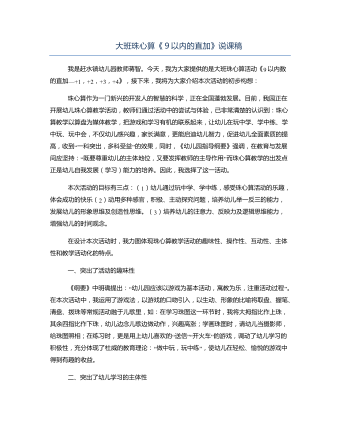
大班珠心算《9以内的直加》说课稿
珠心算作为一门新兴的开发人的智慧的科学,正在全国蓬勃发展。目前,我园正在开展幼儿珠心算教学活动,教师们通过活动中的尝试与体验,已非常清楚的认识到:珠心算教学以算盘为媒体教学,把游戏和学习有机的联系起来,让幼儿在玩中学、学中练、学中玩、玩中会,不仅幼儿感兴趣,家长满意,更能启迪幼儿智力,促进幼儿全面素质的提高,收到“一科突出,多科受益”的效果,同时,《幼儿园指导纲要》强调,在教育与发展间应坚持:“既要尊重幼儿的主体地位,又要发挥教师的主导作用”而珠心算教学的出发点正是幼儿自我发展(学习)能力的培养。因此,我选择了这一活动。本次活动的目标有三点:(1)幼儿通过玩中学、学中练,感受珠心算活动的乐趣,体会成功的快乐(2)动用多种感官,积极、主动探究问题,培养幼儿举一反三的能力,发展幼儿的形象思维及创造性思维。(3)培养幼儿的注意力、反映力及逻辑思维能力,增强幼儿的时间观念。
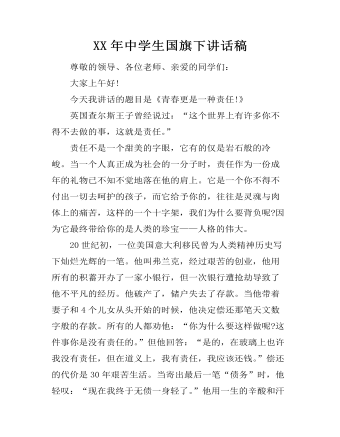
XX年中学生国旗下讲话稿
尊敬的领导、各位老师、亲爱的同学们:大家上午好!今天我讲话的题目是《青春更是一种责任!》英国查尔斯王子曾经说过:“这个世界上有许多你不得不去做的事,这就是责任。”责任不是一个甜美的字眼,它有的仅是岩石般的冷峻。当一个人真正成为社会的一分子时,责任作为一份成年的礼物已不知不觉地落在他的肩上。它是一个你不得不付出一切去呵护的孩子,而它给予你的,往往是灵魂与肉体上的痛苦,这样的一个十字架,我们为什么要背负呢?因为它最终带给你的是人类的珍宝——人格的伟大。20世纪初,一位美国意大利移民曾为人类精神历史写下灿烂光辉的一笔。他叫弗兰克,经过艰苦的创业,他用所有的积蓄开办了一家小银行,但一次银行遭抢劫导致了他不平凡的经历。他破产了,储户失去了存款。当他带着妻子和4个儿女从头开始的时候,他决定偿还那笔天文数字般的存款。所有的人都劝他:“你为什么要这样做呢?这件事你是没有责任的。”但他回答:“是的,在玻璃上也许我没有责任,但在道义上,我有责任,我应该还钱。”偿还的代价是30年艰苦生活。当寄出最后一笔“债务”时,他轻叹:“现在我终于无债一身轻了。”他用一生的辛酸和汗水完成了自己的责任,而给世界留下了一笔真正的财富。